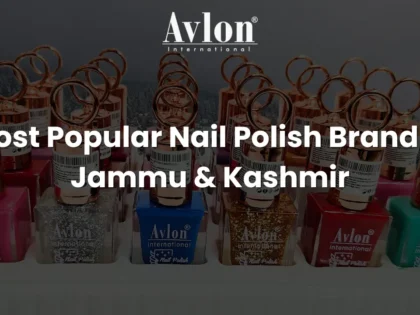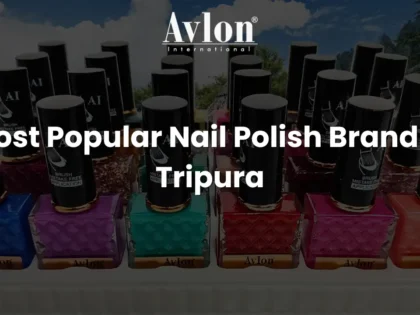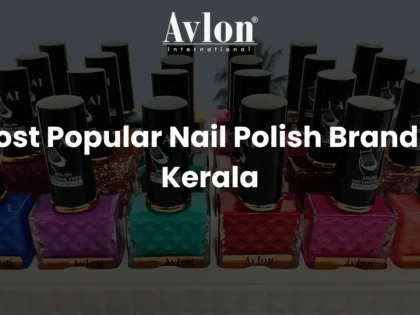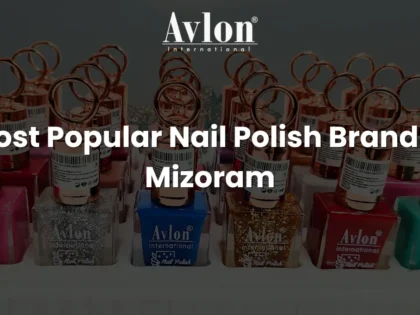5-Free vs 10-Free Nail Polish – What’s the Difference?
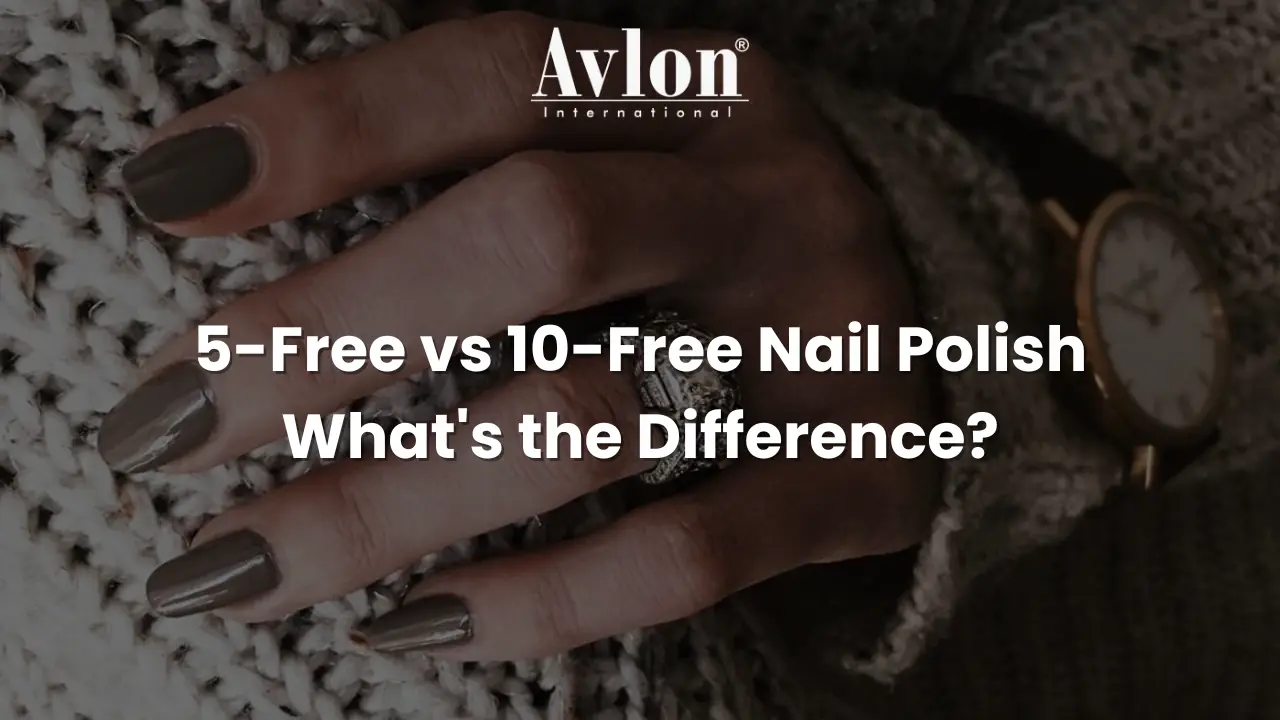
For Distributors & Wholesalers
We welcome partnerships with distributors and wholesalers who wish to expand their business with a trusted and growing cosmetic brand.
Why Partner with Avlon International?
- Wide range of cosmetics: Nail polish, mascara, kajal, eyeliner, liquid lipstick, lipstick & more.
- Premium quality with competitive wholesale pricing.
- Attractive margins and fast-moving products.
- Assured support with marketing materials & promotional offers.
- PAN India shipping with secure packaging.
📦 Minimum Order Quantity (MOQ): 1 master carton (72 trays)
💰 Special Discounts: Available for bulk & long-term partners.
🚚 Dispatch & Delivery: PAN India in around 10-15 days.
📞 Contact Us:
Phone / WhatsApp: +91 88105 67775
Email: contactus@avloninternational.com
Website: www.avloninternational.com
Picture this: You’re standing in the nail polish aisle, feeling like you need a chemistry degree just to understand what you’re buying. Terms like “5-free,” “10-free,” and “toxin-free” are thrown around like confetti at a New Year’s party, but what do they actually mean? And more importantly, why should you care about the difference between 5-free and 10-free nail polish?
Don’t worry – we’re about to decode this colorful mystery together, and by the end of this guide, you’ll be shopping for nail polish like a pro who actually knows what they’re talking about (instead of just pretending to understand while secretly googling “formaldehyde” in the beauty aisle).
The Great Nail Polish Revolution: How We Got Here
Once upon a time, nail polish was basically liquid plastic mixed with enough chemicals to make a science teacher weep. The beauty industry operated under the “if it works, who cares what’s in it” philosophy, which explains why our grandmothers’ nail polish could probably double as paint thinner.
But then something magical happened – consumers started asking questions. Pesky questions like “What exactly am I putting on my nails?” and “Should I be concerned that my nail polish smells like a chemistry lab explosion?” The beauty industry, caught off guard by this sudden interest in ingredient transparency, scrambled to respond.
Enter the “free-from” movement. Brands began proudly displaying numbers on their bottles: 3-free, 5-free, 8-free, and eventually 10-free. It was like a mathematical beauty arms race, with each brand trying to out-“free” the competition.
Breaking Down the Basics: What Does “Free” Actually Mean?
When we talk about “free” in nail polish terms, we’re referring to formulations that exclude certain potentially harmful ingredients. Think of it as the beauty equivalent of ordering your burger without the pickles – except instead of pickles, we’re talking about chemicals with names that sound like rejected superhero villains.
The “free” system started as a way to communicate cleaner formulations to consumers without requiring a doctoral degree in chemistry. It’s beauty marketing at its most practical – bigger numbers generally mean fewer potentially problematic ingredients.
The 5-Free Foundation: Where Clean Beauty Started Getting Serious
5-free nail polish was revolutionary when it first appeared. These formulations exclude five ingredients that had been nail polish staples for decades:
Formaldehyde – This preservative was doing double duty as both a nail hardener and a potential health concern. While it made nails harder than a math test, it also raised eyebrows among health-conscious consumers.
Toluene – This solvent helped create smooth application but came with a side of concerns about nervous system effects. Not exactly the kind of smooth anyone was asking for.
Dibutyl Phthalate (DBP) – This plasticizer prevented chipping but raised questions about endocrine disruption. The irony wasn’t lost on anyone that something designed to make you look good might not be good for you.
Formaldehyde Resin – Related to formaldehyde but slightly different, this ingredient helped polish adhere to nails. It was like formaldehyde’s cousin who shows up uninvited to family gatherings.
Camphor – While it provided glossy shine, excessive exposure raised concerns about skin sensitivity and other health effects.
When brands like Avlon International began formulating 5-free polishes, they were pioneers in the clean beauty space, proving that you could create beautiful, long-lasting color without these traditional ingredients. It was a game-changer that showed the industry – and consumers – that compromise wasn’t necessary.
The 10-Free Evolution: Taking Clean Beauty to the Next Level
If 5-free nail polish was the opening act, 10-free formulations are the headlining performance. These advanced formulations take the clean beauty concept further by excluding an additional five ingredients:
Xylene – Another solvent that helped with application smoothness but raised concerns similar to toluene. It’s like toluene’s problematic sibling.
Parabens – These preservatives were everywhere in beauty products until consumers started questioning their necessity. The beauty industry’s response was essentially “Fine, we’ll find other ways to preserve things.”
Ethyl Tosylamide – This film-forming agent helped polish adhere to nails but wasn’t winning any popularity contests among clean beauty enthusiasts.
Triphenyl Phosphate (TPHP) – This plasticizer was the new kid on the block that quickly became unwelcome at the party.
Acetone – While not inherently evil, acetone in nail polish formulations raised questions about nail health and overall product safety.
The jump from 5-free to 10-free represents the beauty industry’s commitment to continuous improvement. It’s like upgrading from a smartphone with a decent camera to one with a camera so good it makes professional photographers nervous.
The Science Behind the Numbers: Why These Ingredients Matter
Understanding why these ingredients are excluded requires a bit of chemistry knowledge, but don’t worry – we’ll keep it more “fun science class” and less “graduate-level biochemistry.”
Volatile Organic Compounds (VOCs) – Many of the excluded ingredients fall into this category. They evaporate easily, which is why nail polish has that distinctive smell. While that smell might trigger nostalgia for teenage sleepovers, it’s not necessarily something you want to be breathing regularly.
Endocrine Disruptors – Some of these ingredients can interfere with hormone systems. Your endocrine system has enough to worry about without adding nail polish drama to the mix.
Skin Sensitizers – Certain ingredients can cause allergic reactions or skin sensitivity over time. Nobody wants their beauty routine to turn into a medical mystery.
Nail Health Concerns – Some traditional nail polish ingredients can actually damage the nails they’re supposed to beautify. It’s like using a sledgehammer to hang a picture – technically effective but ultimately counterproductive.
Performance Comparison: Do Cleaner Formulations Actually Work?
This is the million-dollar question: Does removing all these ingredients compromise performance? The short answer is no, but the long answer is more interesting.
Durability and Longevity – Modern 10-free formulations, like those developed by Avlon International, have proven that clean doesn’t mean compromised. Advanced polymer technology and innovative ingredient combinations have created formulas that can match or exceed traditional polish performance.
Color Payoff and Vibrancy – Clean formulations have actually improved color technology. Without relying on harsh solvents and additives, formulators have had to get creative with pigments and color delivery systems, often resulting in more vibrant, true-to-bottle colors.
Application Experience – Here’s where the magic really happens. 10-free polishes often apply more smoothly because they’re formulated with better ingredients from the ground up, rather than just removing problematic ones and hoping for the best.
Drying Time – Modern clean formulations dry just as quickly as traditional polishes, and sometimes faster, thanks to improved solvent systems that don’t rely on the excluded ingredients.
The Health and Safety Angle: Why Your Nails (and Body) Will Thank You
Let’s talk about the elephant in the room – or rather, the chemicals in the bottle. While the beauty industry has made tremendous strides in safety, the shift toward cleaner formulations isn’t just a marketing trend; it’s a response to legitimate consumer concerns.
Respiratory Considerations – Those strong chemical smells from traditional nail polish? That’s essentially chemicals evaporating into the air you breathe. Cleaner formulations typically have less aggressive odors and potentially fewer airborne irritants.
Skin Health – The skin around your nails is delicate and can absorb substances applied to it. Cleaner formulations reduce the number of potentially problematic ingredients in contact with your skin.
Nail Bed Health – Your nails are porous and can absorb ingredients from polish. Using cleaner formulations means fewer questionable substances potentially affecting nail health over time.
Pregnancy and Sensitivity Considerations – Many people become more cautious about ingredient exposure during pregnancy or when dealing with chemical sensitivities. Cleaner formulations provide peace of mind during these times.
Professional vs. At-Home Application: Does Formula Type Matter?
Whether you’re a DIY nail artist or a salon regular, the type of formula you choose can impact your experience and results.
Salon Applications – Professional nail technicians often appreciate cleaner formulations because they’re exposed to nail polish fumes all day. Avlon International’s professional-grade 10-free formulations are designed with both client and technician safety in mind.
Home Manicures – For at-home applications, cleaner formulations are often more forgiving. They tend to have less overwhelming odors and are generally easier to work with, especially in poorly ventilated spaces.
Frequency of Use – If you’re someone who changes nail polish weekly (or daily, we don’t judge), cleaner formulations become even more important. The cumulative exposure to potentially problematic ingredients adds up over time.
Environmental Impact: The Bigger Picture
The conversation about nail polish ingredients isn’t just about personal health – it’s also about environmental responsibility.
Manufacturing Footprint – Cleaner formulations often require more sustainable manufacturing processes. Companies like Avlon International have invested in developing eco-friendlier production methods that reduce environmental impact.
Disposal Considerations – When you remove nail polish, those ingredients don’t just disappear. They enter wastewater systems and eventually the environment. Cleaner formulations reduce the environmental burden of our beauty routines.
Packaging Innovation – The clean beauty movement has driven innovation in packaging as well, with many brands adopting more sustainable packaging solutions alongside cleaner formulations.
The Economics of Clean Beauty: Is It Worth the Investment?
Let’s address the practical question: Do cleaner formulations cost more, and if so, are they worth it?
Initial Cost Comparison – 10-free formulations may carry a slight premium compared to conventional polishes, but the gap has narrowed significantly as production scales have increased.
Long-term Value – Cleaner formulations often last longer on nails and maintain their quality in the bottle longer, potentially offering better value over time.
Health Cost Considerations – While difficult to quantify, reducing exposure to potentially problematic ingredients could have long-term health benefits that far outweigh any initial cost difference.
Professional Treatment Savings – Better nail health from cleaner products might reduce the need for professional nail treatments or repairs, saving money in the long run.
Shopping Smart: How to Choose Between 5-Free and 10-Free
Making the choice between 5-free and 10-free formulations depends on several factors:
Sensitivity Levels – If you have sensitive skin or respiratory issues, 10-free formulations offer an extra margin of safety.
Usage Frequency – Heavy nail polish users benefit more from cleaner formulations due to cumulative exposure concerns.
Pregnancy or Health Conditions – During pregnancy or when dealing with health issues, many people prefer the additional peace of mind that 10-free formulations provide.
Personal Values – If clean beauty is important to your lifestyle philosophy, 10-free aligns better with those values.
Budget Considerations – While the cost difference is minimal, it’s still a factor for budget-conscious consumers.
The Future of Nail Polish: Beyond 10-Free
The clean beauty movement shows no signs of slowing down. Industry leaders like Avlon International continue to innovate, exploring even cleaner formulations and more sustainable practices.
Emerging Technologies – New ingredients and manufacturing processes are being developed that could make current clean formulations look primitive by comparison.
Regulatory Changes – Government agencies worldwide are increasingly scrutinizing cosmetic ingredients, which will likely drive further industry improvements.
Consumer Expectations – As consumers become more educated about ingredients, their expectations for cleaner, safer products continue to rise.
Making the Switch: Practical Tips for Transitioning
If you’re ready to make the switch to cleaner nail polish formulations, here are some practical tips:
Start Gradually – You don’t need to throw out your entire nail polish collection overnight. Replace products as you use them up.
Read Labels Carefully – Not all products labeled as “clean” or “natural” are actually 5-free or 10-free. Look for specific ingredient exclusions.
Test New Formulations – Everyone’s nails are different. What works beautifully for your friend might not work as well for you.
Invest in Quality Base and Top Coats – Clean base and top coats from reputable brands like Avlon International can significantly improve the performance and longevity of any polish.
Be Patient with Adjustment – Your nails might need time to adjust to cleaner formulations, especially if they’ve been exposed to harsh chemicals for years.
The Bottom Line: 5-Free vs. 10-Free Nail Polish
The difference between 5-free and 10-free nail polish comes down to the number of potentially problematic ingredients excluded from the formulation. While 5-free was revolutionary when it first appeared, 10-free represents the current gold standard in clean nail beauty.
Both options are significantly cleaner than traditional formulations, but 10-free offers additional peace of mind for health-conscious consumers. The performance gap between clean and conventional formulations has essentially disappeared, thanks to innovative companies like Avlon International that have invested in developing superior clean formulations.
Ultimately, the choice between 5-free and 10-free comes down to personal preference, sensitivity levels, and values. What matters most is that you’re making an informed decision based on your individual needs and circumstances.
The nail polish industry has come a long way from its chemical-heavy origins. Today’s clean formulations prove that you don’t have to compromise beauty for safety, or performance for peace of mind. Whether you choose 5-free or 10-free, you’re participating in a movement toward safer, more sustainable beauty practices.
Your nails – and your health – deserve the best. In a world where we have access to cleaner, safer alternatives that perform just as well as their conventional counterparts, why wouldn’t you make the switch? After all, beauty should enhance your life, not complicate it with unnecessary chemical concerns.
The future of nail polish is bright, clean, and more beautiful than ever. And the best part? You get to be part of that future, one manicure at a time.
📌 Disclaimer
The information provided in this blog is for general informational purposes only. While Avlon International makes every effort to ensure the accuracy and reliability of the information shared, we make no representations or warranties of any kind, express or implied, about the completeness, accuracy, reliability, suitability, or availability with respect to the content.
Any reliance you place on such information is therefore strictly at your own risk. Avlon International shall not be held liable for any loss, damage, or inconvenience arising in connection with the use of this blog or its content.
For official details regarding our products, distributor policies, or business partnerships, please contact us directly at WhatsApp +91 88105 67775.

